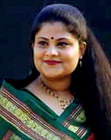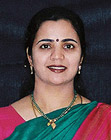
PANDIT BHIMSEN JOSHI – THE MUSIC COLOSSUS – PART 1

‘Mile Sur Mera Tumhara’ (let our voices join in tune) is one of my most striking childhood memories of the attractive vocalism of a true musical giant named Pandit Bhimsen Joshi. Sung in the haunting raaga Bhairavi, this musical montage of the magic that is Indian music still airing on Indian television contains several diverse performers. But the lovely anthem rings clearer and more beautiful because of a gifted vocalist, a household name in India - Pandit Bhimsen Joshi.
The musician has touched the hearts and lives of music lovers, laymen, connoisseurs and music aficionados all over the world. None can deny the power and magnetism of this transformational Hindustani (North Indian classical music) vocalist. He is arguably one of the greatest musicians our generation has witnessed. With Pandit Joshi’s passing Jan. 24, just a few days short of the maestro’s 89th birthday, an esoteric era of Indian music has ended.
Pandit Joshi, who was born in the Gadag district of Karnataka on Feb. 4, 1922, belongs to an esteemed pantheon of Kannada-speaking stalwarts of the Hindustani classical music tradition. A few among them are late vocalists Pandit Kumara Gandharva, Pandit Mallikarjuna Mansur, Dr. Gangubai Hanagal and Pandit Basavaraj Rajguru. Gangubai was Pandit Joshi’s guru-bandhu or fellow disciple of Pandit Sawai Gandharva (a k a Rambhau Kundgolkar), who also hailed from Karnataka.
Pandit Sawai Gandharva was an exponent of Kirana gharana (school of Hindustani classical music). Pandit Joshi strictly speaking had thus internalized the nuances and intricacies of the Kirana style of vocalism pioneered by Ustad Abdul Karim Khan. Nevertheless, Pandit Joshi imbibed some of the most attractive and masterful aspects and techniques of other gharanas and styles as well. The genius that Pandit Joshi was, his unique, robust and masterful singing and soul stirring music are completely original and inimitable. Having the good fortune of attending many live concerts of the late maestro, I can vouch firsthand for the fact that this amazing performer was a force of nature. His vocalism was characterized by vociferous, explosive taans (note oscillations) and bold improvisations juxtaposed with an appealing tenderness and emotional elaboration of any raaga or melodic entity that Pandit Joshi expounded.
The raagas Multani, Durga, Malhar, Tilak Kamod and Shudh Kalyan are so fresh in my memory. Pandit Joshi’s masterful live renditions and recordings of these rich Indian classical melodies are considered as the gold standard by many performers. The haunting and heightened emotion of ‘Ata Jhooma Re,’ a composition in raaga Malhaar that personifies rain clouds, thunder and lightning, or the mesmerizing melody of the raaga Tilak Kamod – ‘Teeratha To Saba Kare,’ create spiritual awakenings in a musical heart. Such is the power his Joshi’s music. The quintessential raaga Durga renditions ‘Tu Ras Kan Re’ and ‘Chatura Sughara’ – medium- and fast-paced compositions respectively are immortal. The impressive and bombastic taan express of Pandit Joshi’s raaga Multani – especially the dhruta (fast-paced) bandish/composition ‘Nainan Mein Aan Baan’ demonstrates the artist’s vocal technical prowess as well as his immense ‘Saadhana’ or the depth of perseverance.
The artist’s voice has reached even the most remote corners of India and many legends and anecdotes are associated with this stalwart and star. It is said that in the 1980s when bandits confronted Pandit Joshi, they left him unharmed after learning who he was.
To be continued
Lavanya Dinesh is an accomplished performer and teacher of Hindustani classical vocal music and resides in Tampa. Dinesh, who has three album releases to her credit, also has worked as a music critic and feature writer for Times of India and Deccan Herald. She can be reached at [email protected]
Dance
DANCE & YOGA

Shiva in the dancing form as Nataraja symbolizes that he is the Master of Yoga. In his joyful, ecstatic, blissful dance of the cosmos the Ananda Tandavam, his arms, with the damaru, fire, blessing and protective gestures, his legs, the left one lifted up and the right rooted firmly to the ground represents him as the greatest yogi among the Hindu Gods.
The word Yoga comes from the Sanskrit word "Yuj" meaning to yoke, join or unite. This implies joining or integrating all aspects of the individual – body with mind and mind with soul – to achieve a happy, balanced and useful life, and spiritually, uniting the individual with the supreme. The classical techniques of Yoga date back more than 5,000 years.
The Indian sage Patanjali is believed to have collated the practice of yoga into the Yoga Sutra about 5,000 years ago. The Sutra is a collection of 195 statements that serves as a philosophical guidebook for most of the yoga that is practiced today. It also outlines eight limbs of yoga: the yamas (restraints), niyamas (observances), asana (postures), pranayama (breathing), pratyahara (withdrawal of senses), dharana (concentration), dhyani (meditation), and samadhi (absorption). As one explores these eight limbs, he begins by refining his behavior in the outer world, and then focuses inwardly until he reaches samadhi liberation, enlightenment.
Classical dance and Yoga transforms one from the ordinary to the enchanted. Yoga and dance traditions have been inextricably entwined for ages. Both have a close connection with spirituality and religion. Yoga and classical dance stress total devotion to the guru and emphasize determined and dedicated practice for complete success.
Bharatanatyam has always been associated as an art used to achieve a union with the divine. If yoga means union then this classical dance form is yoga. The hand gestures, movements, different body postures can all be achieved only through yogic concentration. Conversely, the dynamism and esthetics of dance enhance the practice of yoga.
Bharata’s Natya Shastra describes in great detail the movements of the body. There are 108 Karnas, which are the fundamental dance poses, upon which is based all the technique of movement. A Karana is composed of the movement of the legs and the hands, which means the body as a whole. To understand these Karanas, a dancer has to master the movement of each part of the body such as the neck, head, feet, thighs, waist and hands .The evidence of the 108 Karnas is clear in the sculptures and paintings on the walls, Gopurams and courtyards of out ancient temples, especially in Chidambaram and Kumbakonam in south India, where dancers are depicted in acrobatic stances. These stances are similar to the innumerable Yogic Asanas. Many classical dance poses on the walls of the Chidambaram temple are also popular Yogic asanas that are practiced all over the world today.
It is believed that Yoga helps in achieving flexibility, which is important in performing a lot of these poses in dance. Sincere and regular practice of Yoga from early childhood helps to re-create the poses efficiently and become experts in artistic presentation of this dance form.
The great dancer BalaSaraswati has rightly called the practice of Bharatanatyam as an artistic yoga for revealing the spiritual through the corporeal.
Jyothi Venkatachalam, director of Abhyasa School Of Dance, Club Tampa Palms, offers classes in Bharat Natyam, traditional folk dances, Indian percussion instruments (Mridangam, Dholak, Ghatam, Kanjira, Morsingh and Konakol). She can be reached at (813) 977-9039 or (813) 404-7899 or via e-mail at [email protected]